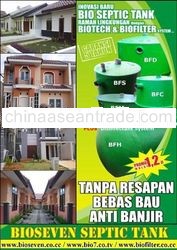Dear valued customers,
Please consider the following features when you are looking to purchase a septic tank and you'll find that BioSeven septic tanks will exceed your expectations when it comes to performance and longevity.
The common septic tank is a single-story, watertight, on-site treatment system for domestic sewage, consisting of one or more compartments, in which the sanitary flow is detained to permit concurrent sedimentation and sludge digestion. The septic tank is constructed of materials such as precast concrete, reinforced concrete, concrete block, or reinforced resin and fiberglass.
The common septic tank do not treat sewage; they merely remove some solids and condition the sanitary flow so that it can be safely disposed of to a subsurface facility such as a tile field, leaching pools, or buried sand filter. Septic tank effluent is highly odorous, contains finely divided solids, and may contain enteric pathogenic organisms. The small amounts of gases produced by the anaerobic bacterial action are usually vented and dispersed to the atmosphere without noticeable odor or ill effects.
Our Bioseptic tank BioSeven equipted with :
*Primary treatment employs mechanical and physical unit processes to separate and remove floatables and suspended solids and to prepare wastewater for biological treatment. *Secondary treatment utilizes aerobic microorganisms in biological reactors to feed on dissolved and colloidal organic matter. As these microorganisms reduce biochemical oxygen demand and turbidity (suspended solids), they grow, multiply, and form an organic floc, which must be captured and removed in final settling tanks.
*Tertiary treatment, or advanced treatment, removes specific residual substances, trace organic materials, nutrients, and other constituents that are not removed by biological processes.
BioSeven septic tank are proud to offer biotech & biofilter system series Septic Tanks, with mean the tank undergo a process of liquefaction and anaerobic decomposition by bacterial organisms.
Bioseptic tank BioSeven are constructed of fiberglass materials, should last about 50 years, not subject to decay, corrosion, or decomposition and require no additional coatings as other tanks do.
BioSeven septic tanks are fitted with honeycomb media placed in the bottom and biological reactors (Bio media cell), floats to feed on dissolved and colloidal organic matter, where the bacteria (Anaerobe microorganisms) live that treat the waste.
BioSeven septic tanks are designed for durability and quick, easy installation.
BioSeven septic tanks range, are available as single compartment or double compartment tanks (2/3 - 1/3).
BioSeven septic tanks are disinfectant feeder included, to removed pathogens contains, that cause disease, such as bacterium and viruses, which need to decompose before they can be released safely into the environment and with no odor effluent.
BioSeven septic tanks offers you proven products that you can count on for years of dependable, trouble-free service.
BioSeven septic tanks are manufactured by means of the rotational molding process which produces a one-piece, seamless, watertight tank.
BioSeven septic tanks rib design and rib placement provide superior structural integrity to the tank.
BioSeven septic tanks are shipped to you ready for installation.
BioSeven septic tanks are backed by a full Five-year warranty.
*BioTech system or biotechnology is use biological processes (Bioprocess engineering), as through the exploitation and manipulation of living organisms and applied the biological systems to carry out technical processes and tissue culture technologies, in the development or manufacture of a product or in the technological solution to a domestic sewage problem, such as septic tanks.
*BioFilter system or Biofiltration is a pollution control technique using living material (Biofiltration engineering) to capture and biologically degrade process pollutants. Common uses include processing domestic sewage / waste water, such as septic tanks, capturing harmful chemicals or silt from surface runoff, and microbiotic oxidation of contaminants in air.




